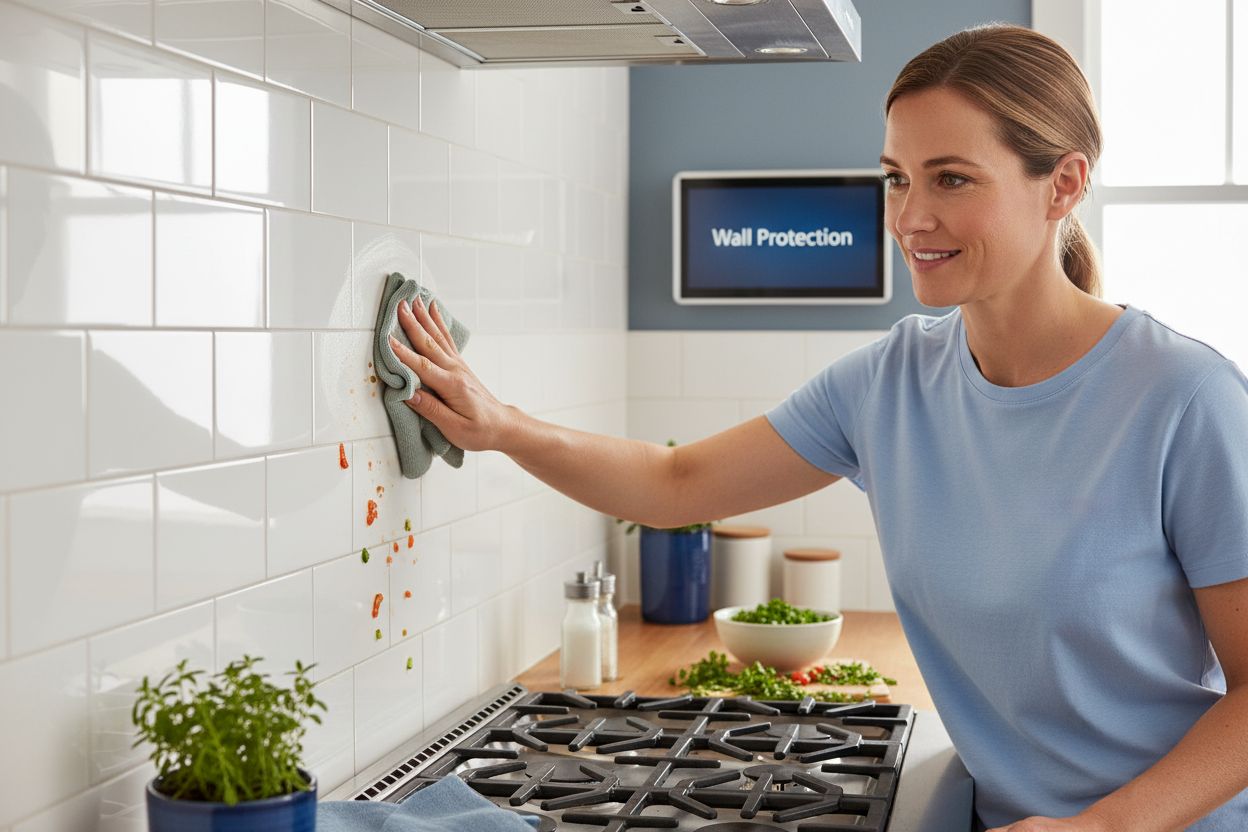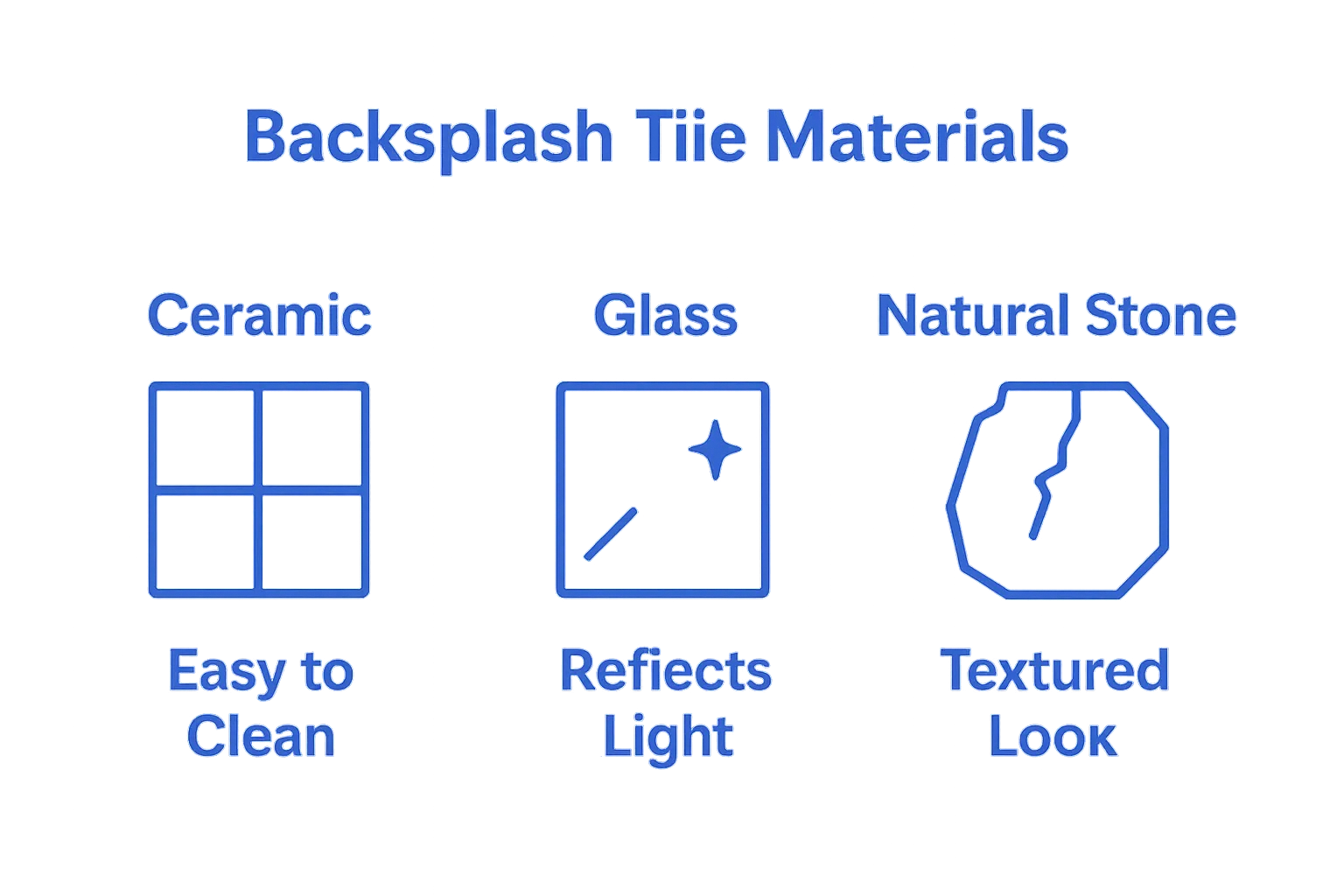Why Install Backsplash Tile? Understanding Its Benefits
Posted by Mike Belk on Oct 13, 2025

Backsplash tile is that sleek layer you see behind kitchen counters and stoves, and most people think it is just for adding a pop of color. But here is something people miss. Ceramic, glass, and porcelain backsplash tiles can actually stop moisture, grease, and food from ruining your walls, making kitchens far easier to keep clean. That protective power matters more than you might guess, and the right tile choice could even help prevent mold in your home.
Table of Contents
- Understanding Backsplash Tile: What Is It?
- The Importance Of Backsplash Tile In Design
- Functional Benefits Of Installing Backsplash Tile
- Materials And Styles: Choosing The Right Backsplash
- Real-World Applications: Backsplash Tile In Homes And Businesses
Quick Summary
| Takeaway | Explanation |
|---|---|
| Backsplash tiles protect walls | They safeguard against moisture, grease, and food splatters that can damage underlying surfaces. |
| Material selection impacts performance | Choose tiles based on durability, moisture resistance, and ease of cleaning to maximize functionality. |
| Tiles enhance aesthetic appeal | Various colors, patterns, and textures allow homeowners to create a unique design statement. |
| Easy maintenance is essential | Non-porous surfaces of ceramic and glass tiles facilitate quick cleaning and promote hygiene. |
| Versatile applications exist | Backsplash tiles are suitable for kitchens, bathrooms, and commercial spaces needing aesthetic and functional benefits. |
Understanding Backsplash Tile: What Is It?
A backsplash tile is a protective and decorative wall covering typically installed in areas prone to splashes, moisture, and food debris like kitchen walls behind stoves, sinks, and countertops. Discover the best tile types for your backsplash to enhance both functionality and aesthetic appeal.
Defining the Purpose of Backsplash Tiles
Backsplash tiles serve multiple critical functions beyond mere visual enhancement. These specialized wall coverings are engineered to provide robust protection against moisture, grease, and food splatters that can damage underlying wall surfaces. Ceramic, porcelain, and glass tiles are particularly effective in creating a durable barrier that prevents water penetration and makes cleaning significantly easier.
The primary purposes of backsplash tiles include:
- Protecting wall surfaces from moisture and stains
- Providing easy-to-clean surface for high-traffic kitchen areas
- Adding decorative visual interest to kitchen and bathroom spaces
Construction and Material Considerations
Backsplash tiles are manufactured through precise processes that ensure durability and aesthetic versatility. According to National Kitchen and Bath Association, quality backsplash tiles undergo rigorous testing to withstand daily kitchen and bathroom environments. Manufacturers select materials with specific properties like low water absorption, high resistance to temperature variations, and superior durability.
The selection of backsplash tile materials depends on several factors including location, exposure to moisture, cleaning requirements, and desired aesthetic. Common materials range from traditional ceramic and porcelain to more contemporary options like glass, natural stone, and metallic finishes. Each material offers unique characteristics that impact both performance and visual appeal.
The table below compares common backsplash tile materials based on their performance, maintenance, and design attributes to help guide informed selection.
| Material | Durability | Moisture Resistance | Ease of Cleaning | Design Versatility |
|---|---|---|---|---|
| Ceramic | High | High | Very easy | Wide range of styles |
| Porcelain | Very high | Excellent | Very easy | Many colors/patterns |
| Glass | Moderate-High | Excellent | Very easy | Reflective, modern |
| Natural Stone | Variable | Moderate | Moderate, may stain | Unique textures |
| Metallic | Moderate | High | Easy | Sleek, contemporary |
By understanding the fundamental purpose and construction of backsplash tiles, homeowners can make informed decisions that balance practical functionality with design excellence.
Here is a summary of the main functional and design benefits of installing backsplash tile, showcasing how it transforms both kitchens and bathrooms.
| Benefit | Functional Impact | Design Impact |
|---|---|---|
| Wall Protection | Shields against moisture, grease, and food splatters | Preserves wall and structural health |
| Easy Maintenance | Non-porous surfaces are simple to wipe clean | Supports kitchen hygiene |
| Mold & Mildew Prevention | Reduces risk of mold in high-moisture areas | Lowers long-term upkeep needs |
| Aesthetic Enhancement | N/A | Adds color, texture, and personality |
| Design Versatility | N/A | Wide choice of patterns and finishes |
| Long-Term Durability | Withstands daily kitchen and bathroom use | Maintains beauty over years |
The Importance of Backsplash Tile in Design
Backsplash tiles are not merely functional elements but powerful design statements that transform kitchen and bathroom aesthetics. Explore expert tips for selecting the perfect kitchen backsplash to elevate your interior design vision.
Visual Impact and Design Versatility
In interior design, backsplash tiles serve as a critical visual anchor that can dramatically alter a room’s perceived style and atmosphere. Color, pattern, and texture play pivotal roles in creating visual interest and connecting different design elements. Whether choosing subtle neutral tones or bold geometric patterns, backsplash tiles offer remarkable design flexibility.
Design considerations for backsplash tiles include:
- Creating visual continuity with countertops and cabinetry
- Introducing color and texture without major renovation
- Reflecting personal design aesthetic and home style
Transforming Spaces Through Strategic Design
According to Houzz design experts, backsplash tiles are transformative design elements that can make spaces feel larger, brighter, and more cohesive. By strategically selecting tile materials, colors, and layouts, homeowners can create optical illusions that enhance spatial perception.
For instance, light-colored glass tiles can reflect more light and create an expansive feeling, while vertically laid subway tiles can make ceilings appear higher. Metallic or reflective tiles introduce dimension and movement, breaking monotonous wall surfaces and adding depth to kitchen and bathroom environments.
The strategic selection of backsplash tiles represents a sophisticated approach to interior design, where functionality meets artistic expression.
Functional Benefits of Installing Backsplash Tile
Backsplash tiles are engineered solutions that provide far more than aesthetic appeal. Learn about the advantages of ceramic tile backsplashes to understand their comprehensive functional benefits.
Wall Protection and Durability
One of the primary functional advantages of backsplash tiles is their exceptional ability to protect wall surfaces from potential damage. Moisture, grease, and food splatters can quickly deteriorate standard painted walls, leading to staining, mold growth, and structural degradation. Backsplash tiles create an impenetrable barrier that shields walls from these destructive elements.

Key protective features include:
- Resistance to water penetration
- Prevention of mold and mildew development
- Easy removal of grease and food residue
- Long term preservation of wall integrity
Maintenance and Hygiene Benefits
According to This Old House renovation experts, backsplash tiles offer unparalleled ease of cleaning and maintenance. Unlike porous surfaces that trap bacteria and require intensive scrubbing, ceramic, glass, and porcelain tiles feature smooth, non absorbent surfaces that can be quickly wiped clean with minimal effort.
The hygienic properties of backsplash tiles make them ideal for areas with high moisture and food preparation activities. Smooth tile surfaces prevent bacterial accumulation, reducing potential health risks associated with difficult to clean wall coverings. Homeowners can maintain a cleaner, more sanitary kitchen environment with strategic tile selection.
By combining robust protection, effortless maintenance, and superior durability, backsplash tiles represent a smart investment in both home aesthetics and functional performance.
Materials and Styles: Choosing the Right Backsplash
Selecting the perfect backsplash tile involves balancing aesthetic preferences with practical performance requirements. Explore elegant kitchen backsplash tile solutions to discover the ideal match for your design vision.
Popular Backsplash Tile Materials
Ceramic and porcelain tiles remain the most versatile and popular backsplash materials, offering exceptional durability and design flexibility. These materials come in countless colors, patterns, and textures, enabling homeowners to create unique visual statements while maintaining practical functionality.
Key material considerations include:

- Durability and wear resistance
- Moisture and stain repellent properties
- Ease of cleaning and maintenance
- Cost effectiveness
- Design versatility
Design Styles and Aesthetic Considerations
Backsplash tiles can dramatically transform kitchen and bathroom aesthetics by introducing visual depth, color, and texture. From classic subway tiles to intricate mosaic patterns, the design possibilities are virtually limitless. Contemporary designs often feature large format tiles, geometric patterns, and unexpected color combinations that create striking visual impact.
According to National Park Service preservation guidelines, material selection should consider not just aesthetic appeal but long term performance and compatibility with existing architectural elements. Homeowners should evaluate how different tile materials and styles integrate with existing countertops, cabinetry, and overall room design.
The strategic selection of backsplash tiles represents a nuanced design decision that balances personal style, functional requirements, and long term visual harmony.
Real-World Applications: Backsplash Tile in Homes and Businesses
Backsplash tiles transcend residential spaces, finding critical applications in diverse environments that demand both functionality and aesthetic appeal. Discover the latest tile trends and insights to understand their versatile potential.
Residential Space Implementations
Kitchens and bathrooms represent the primary domains where backsplash tiles showcase their transformative potential. Homeowners leverage these specialized wall coverings to create visually stunning yet highly practical surfaces that withstand daily wear and moisture exposure. From cooking areas prone to grease splatters to bathroom walls experiencing constant humidity, backsplash tiles provide robust protection while maintaining aesthetic elegance.
Key residential application areas include:
- Kitchen cooking zones behind stoves and countertops
- Bathroom walls surrounding sinks and shower enclosures
- Laundry room utility spaces
- Wet bar and entertainment areas
- Outdoor kitchen installations
Commercial and Professional Environments
According to National Park Service preservation guidelines, tile backsplashes play crucial roles in commercial settings where sanitation and durability are paramount. Restaurants, medical facilities, commercial kitchens, and public restrooms rely on backsplash tiles to meet stringent hygiene standards and withstand intensive daily use.
Professional environments benefit from backsplash tiles through:
- Easy sanitization and cleaning protocols
- Resistance to chemical cleaning agents
- Compliance with health and safety regulations
- Long term durability under high traffic conditions
- Professional and polished aesthetic appearance
By bridging aesthetic sophistication with practical performance, backsplash tiles demonstrate remarkable versatility across residential and commercial landscapes.
Bring Your Dream Backsplash Project to Life with BELK Tile
Have you ever worried about stubborn stains, moisture damage, or outdated designs in your kitchen or bathroom? The article highlights how the right backsplash tile solves these everyday problems through protection, durability, and stunning style. You do not have to settle for wall surfaces that are hard to clean or lack personality. With BELK Tile, you gain access to a world of high-quality tile solutions tailored to protect your space while elevating its look. Discover everything from vibrant glass mosaic and timeless ceramic to modern porcelain and natural stone—each option designed to combine easy maintenance with visual impact.
Are you ready to transform your kitchen or bathroom into a space that looks beautiful and stays protected for years? Explore our extensive inspiration and ideas to find the perfect match for your next project. Visit BELK Tile’s homepage now and experience how easy it can be to shop, filter, and upgrade your home with tiles that deliver real results. Shop today and make your renovation goals a reality.
Frequently Asked Questions
What is the primary function of backsplash tiles?
Backsplash tiles primarily serve to protect wall surfaces from moisture, grease, and food splatters while also providing an easy-to-clean surface in high-traffic kitchen and bathroom areas.
What materials are commonly used for backsplash tiles?
Common materials for backsplash tiles include ceramic, porcelain, glass, natural stone, and metallic finishes. Each material offers unique durability and design characteristics suitable for different environments.
How do backsplash tiles contribute to kitchen design?
Backsplash tiles can dramatically enhance kitchen design by adding color, texture, and pattern, creating visual continuity with countertops and cabinetry while reflecting personal aesthetic tastes.
What are the cleaning benefits of installing backsplash tiles?
Backsplash tiles are non-porous and easy to clean, making them ideal for areas prone to moisture and food preparation activities. They help prevent bacterial accumulation and maintain a clean, hygienic kitchen environment.



